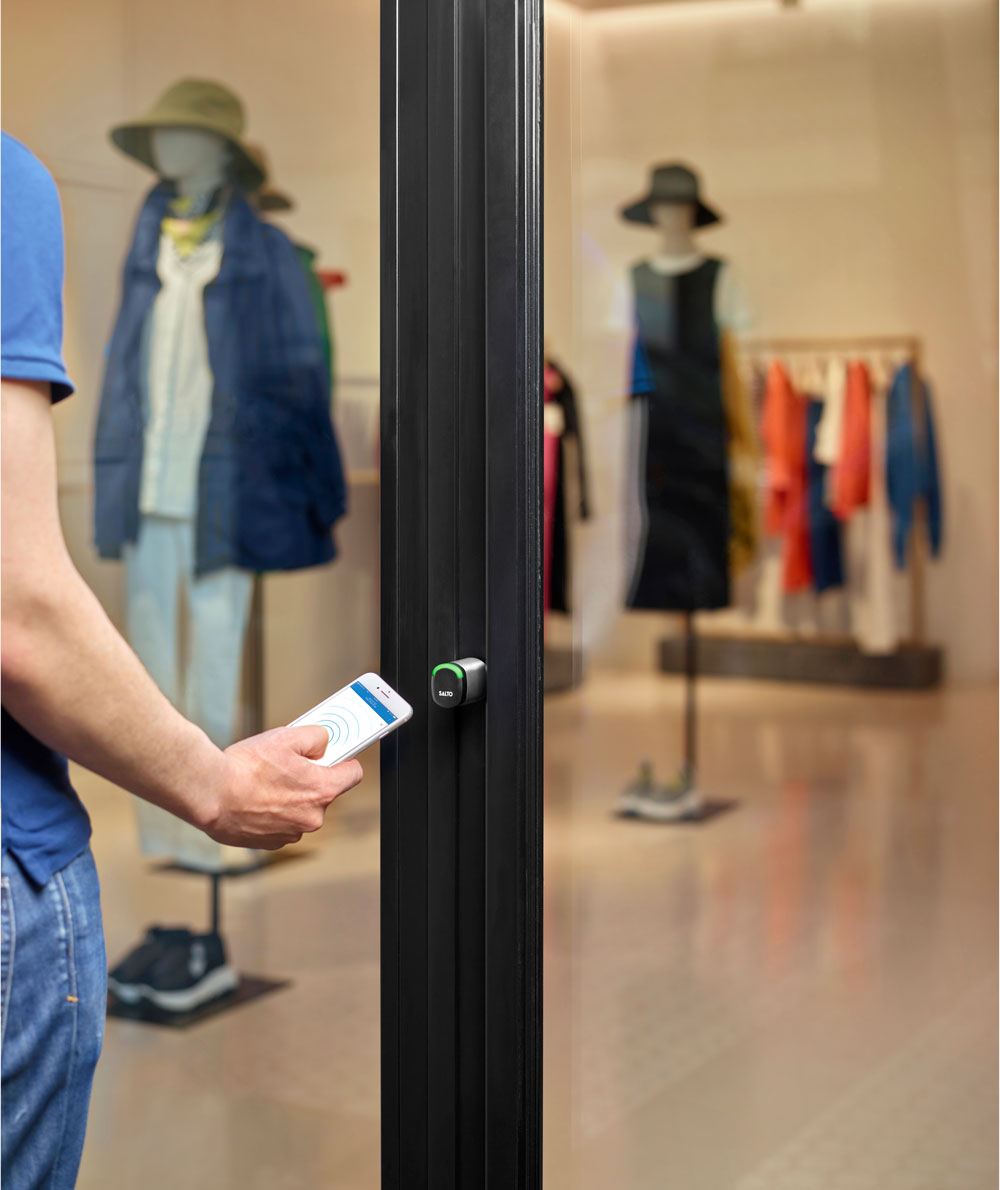“Dark deliveries” is a term that refers to receiving shipments in retail facilities when the store is closed or minimally staffed. “This can happen late at night, early in the morning, or when the retail operation is outside its peak activity mode,” says John Wright, Retail & Fitness Industry Business Leader at SALTO Systems.
While dark deliveries aren’t a new concept, they’ve recently gained more attention due to the increase in e-commerce and the need for efficient, round-the-clock operations. Wright notes that the Covid-19 pandemic also increased the trend toward dark deliveries in order to minimize interpersonal contact. “What’s new, however, is the advanced wireless access control technology — like SALTO KS — that makes managing dark deliveries more secure and efficient than ever before,” he adds.
The Basics of Wireless Access Control
One of the important features of wireless access control is how it is able to manage permissions remotely. Retail managers don’t need to be onsite to allow access, and they can specify certain windows of time during which delivery drivers can access the facility, all from a smartphone or computer.
This level of control has multiple benefits. It not only limits delivery access to specific windows of time during off-hours — it records who entered the facility and when. If a security issue should arise, this audit trail is key to investigating it. If unauthorized access should occur or a door is left open, real-time notifications alert management of the breach.
Another important benefit of wireless access control is how easy the system is to install. It doesn’t require expensive wiring and allows for a faster and smoother transition to dark deliveries. And as the retail operation grows, wireless systems are easier to scale up than traditional wired systems. This might involve additional retail locations, storage facilities or loading docks.
How Wireless Access Works
Wireless access control is managed remotely in the cloud. Access permissions are configured through a centralized management platform, usually accessible through a web browser or mobile app. This enables management to adjust permissions as necessary from anywhere at any time.
Entry to the facility can be scheduled for specific hours. However, should a delivery driver arrive at an unscheduled time, temporary access can be granted. For one-time or infrequent drivers, temporary access codes can be issued which expire after a set period of time. In an emergency situation, doors can be instantly locked or unlocked from the management platform, allowing for a quick response.
Security is an important feature of wireless access control. It can be set up to require multi-factor authentication, necessitating a second form of verification to enter the facility. Additional security is also provided through advanced encryption applied to the data collected by the system. “This ensures that information like access codes and logs are secure from cyberthreats,” says Wright. He notes that wireless access control can also integrate with other security systems, like closed-circuit TV, alarms and inventory control systems, becoming an integral part of a comprehensive security strategy.
Because the locks are battery-operated, they are easy to install and maintain, requiring no wiring. Battery life can be monitored remotely, ensuring the locks are always operational.
Real Benefits
Wireless access control reduces shrinkage, says Wright. “One of the primary areas where retailers experience losses is through shrinkage, which includes theft, fraud and inventory errors. Wireless access control helps by strictly regulating who has access to inventory areas, thereby reducing opportunities for theft.” The audit trails provided by the wireless systems makes it easy to track who has been where and when. This increases accountability among staff and contractors, and deters theft and mishandling of goods.
For retail businesses with compliance concerns, failing to adhere to regulations about who can access certain areas and when they’re permitted to can result in significant fines. Wireless access control monitors facility security and helps retailers avoid these financial penalties.
These systems offer additional financial benefits as well. Insurance premiums may be reduced due to decreased opportunity for theft, and the number of staff required to be on-premises during off-hours to receive deliveries can be reduced.
Other benefits include:
- Reduced risk of litigation by providing evidence in the event of an incident
- Vendor accountability, ensuring that deliveries are being made on time
- Providing cleaning and maintenance crew access during off-hours
- The ability to better manage energy usage, since smart access can be integrated with lighting and climate control systems
- Private shopping appointments for VIP customers
The real benefits of wireless access control can’t be overstated. Having complete control of who enters the retail establishment and when provides additional security, efficiency and financial advantages that mechanical locks simply cannot.
Related Stories
Retail Centers | Mar 10, 2015
Orlando's Skyscraper to be world's tallest roller coaster
The Skyscraper is expected to begin construction later this year, and open in 2016. It will stand at 570 feet.
Codes and Standards | Mar 5, 2015
Charlotte, N.C., considers rule for gender-neutral public bathrooms
A few other cities, including Philadelphia, Austin, Texas, and Washington D.C., already have gender-neutral bathroom regulations.
Office Buildings | Feb 18, 2015
Commercial real estate developers optimistic, but concerned about taxes, jobs outlook
The outlook for the commercial real estate industry remains strong despite growing concerns over sluggish job creation and higher taxes, according to a new survey of commercial real estate professionals by NAIOP.
Mixed-Use | Feb 13, 2015
First Look: Sacramento Planning Commission approves mixed-use tower by the new Kings arena
The project, named Downtown Plaza Tower, will have 16 stories and will include a public lobby, retail and office space, 250 hotel rooms, and residences at the top of the tower.
Codes and Standards | Feb 12, 2015
New Appraisal Institute form aids in analysis of green commercial building features
The Institute’s Commercial Green and Energy Efficient Addendum offers a communication tool that lenders can use as part of the scope of work.
Modular Building | Feb 12, 2015
New shipping container complex begins construction in Albuquerque
The Green Jeans Farmery already has a hydroponic farm component courtesy of owner and entrepreneur Roy Solomon.
| Jan 7, 2015
4 audacious projects that could transform Houston
Converting the Astrodome to an urban farm and public park is one of the proposals on the table in Houston, according to news site Houston CultureMap.
Smart Buildings | Jan 7, 2015
Best practices for urban infill development: Embrace the region's character, master the pedestrian experience
If an urban building isn’t grounded in the local region’s character, it will end up feeling generic and out-of-place. To do urban infill the right way, it’s essential to slow down and pay proper attention to the context of an urban environment, writes GS&P's Joe Bucher.
| Jan 2, 2015
Construction put in place enjoyed healthy gains in 2014
Construction consultant FMI foresees—with some caveats—continuing growth in the office, lodging, and manufacturing sectors. But funding uncertainties raise red flags in education and healthcare.
| Dec 29, 2014
New data-gathering tool for retail designers [BD+C's 2014 Great Solutions Report]
Beacon technology personalizes smartphone messaging, creating a new information resource for store designers. It was named a 2014 Great Solution by the editors of Building Design+Construction.














